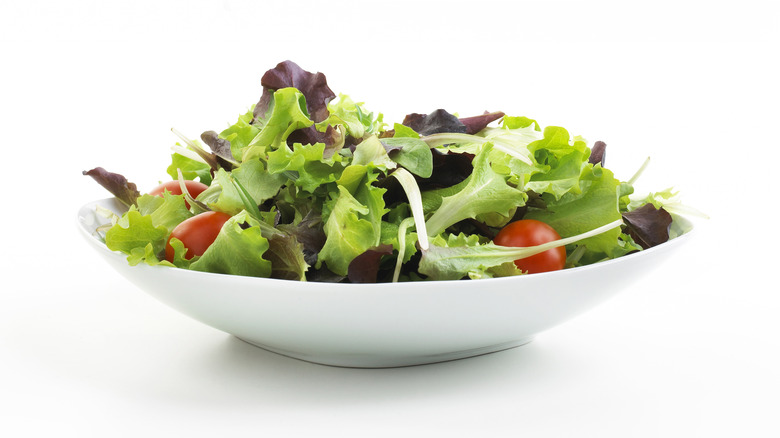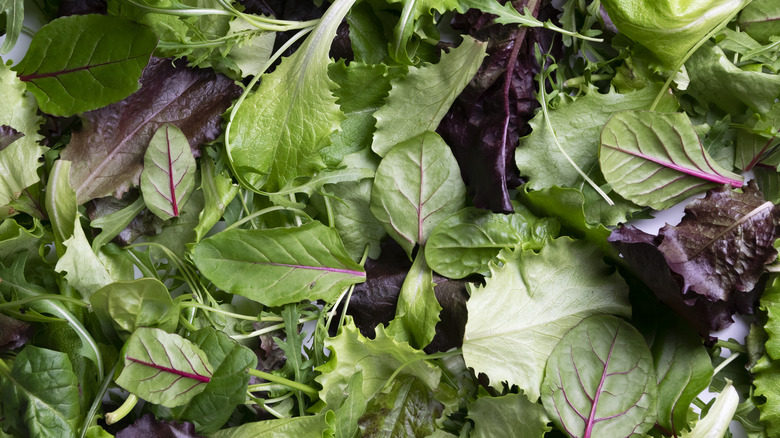The Name 'Salad' Refers To Something You May Not Expect
We all know what salad is, right? That might sound like a ridiculous thing to even bother asking, but actually stop and consider for a moment what the definition of a salad is. Your first thought probably centers on lettuce, but what then do we make of pasta salad, tuna salad, or those strange Jell-O-based salads of the mid-1900s, à la Watergate salad? None of these dishes contain any lettuce, yet they bear the name "salad" all the same. The more you think about salad, the less clear its meaning becomes, as countless lettuceless varieties come to mind, like chicken salad or fruit salad. You might wonder if these dishes represent some warping of the word's original meaning, but it turns out the name "salad" comes from the last ingredient you'd expect it to.
The word "salad" entered the English language around the 14th century, sometimes being spelled in the familiar fashion, but other times being written as "sallet." It came to English via the Old French "salade," which in turn descends from the Latin word "salata," meaning, of all things, "salted." The ancestry is even more apparent in the Italian and Spanish words for "salad" ("insalata" and "ensalada" respectively). Salt probably isn't the first ingredient that comes to your mind when you think of salads. How could this hallmark of healthy eating bear a name more suited for potato chips or french fries? But if we look back in history to the earliest iterations of salad, the reasoning behind its name makes perfect sense.
The origin of salad
Salads as we know them first appeared in the cuisines of ancient Greece and Rome. The original versions were nearly identical to the green salads we still eat today, being simple compositions of seasonal vegetables chopped up and served with a dressing. Our tendency to eat salad as a first course can actually be attributed, at least in part, to the Greek physician Hippocrates, who argued that raw vegetables moved through the digestive tract with ease, leaving it clear for the following courses, while eating your main dish first could create obstructions in the gut. It turns out he was fairly far off the mark in this belief, as the fibrous nature of raw vegetables actually makes them a powerful trigger for irritable bowel syndrome (per Verywell Health) but old habits die hard it seems.
Disregarding the veracity of his medical wisdom, we know that Hippocrates likely enjoyed his salads with a very simple vinaigrette composed of oil, vinegar, and salt. It is this final ingredient to which we owe the name salad. The Latin word for "salt" is "sal," and those early dishes made from dressed vegetables became known as "herba salata," or "salted herbs." The term may also have been used to refer to vegetables that were pickled in vinegar and salt. Thus, etymologically at least, the defining element of a salad is its dressing; but the question remains as to how the name of a simple dish of mixed vegetables came to have so many applications.
The evolution of salad
After the fall of the Roman Empire, salad saw a sharp decline in popularity. For centuries, raw vegetables were eaten mainly for medicinal purposes, or during times of fasting. Fortunately, the Byzantine Empire kept the tradition of salad alive; and, when the Renaissance era dawned, Western Europe embraced it once again. The nobility began eating salads with meat in them, transforming the dish into something worthy of a main course.
This gave rise to bound salads — which eschew leafy greens in favor of entree staples like meat and potatoes — bound, as it were, by some form of dressing. The concept then dovetailed with the invention of mayonnaise in the 1750s, giving rise to things like tuna salad, potato salad, and chicken salad, the invention of which is widely attributed to a Rhode Island chef named Liam Gray in 1863. However, some contest that chicken salad actually descends from an 18th-century Russian dish.
As for those gelatinized salads of the 20th century, they arose from humanity's seemingly innate need for control. Starting around the tail end of the 1800s, the domestic science movement (also known as home economics) became quite concerned with orderliness, and the appearance of tossed vegetables on a plate simply wasn't pristine enough in many people's eyes. The advent of Jell-O offered a means for literally molding food in the image one desired. This trend, of course, did not last long; and, today, salads are most commonly presented in something quite close to their original form.


